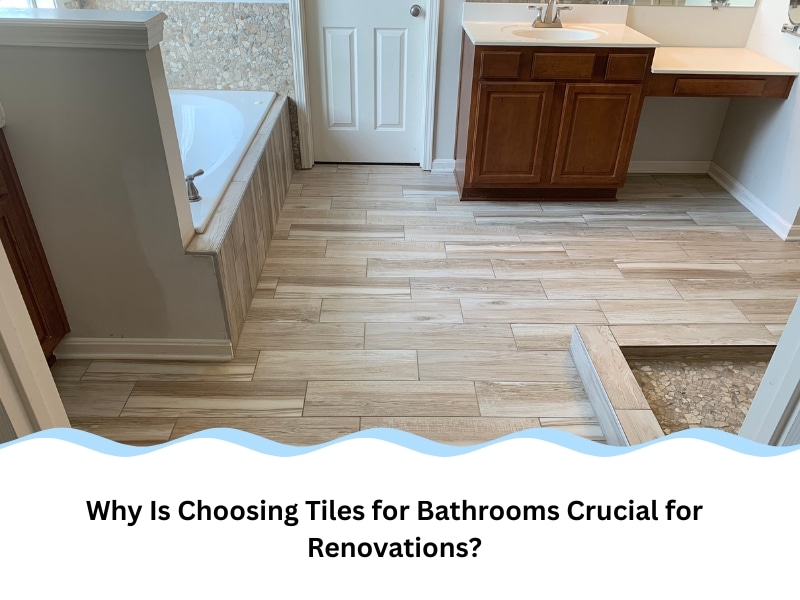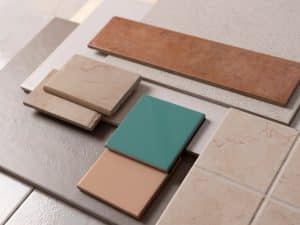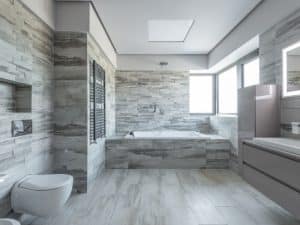When it comes to bathroom renovations, choosing tiles for bathrooms is one of the most important decisions you’ll make. Not only do tiles impact the overall aesthetic, but they also affect functionality, safety, and long-term maintenance. Whether upgrading a tired ensuite or designing a custom main bathroom, the right tile choice can completely transform the space. This article will explore why tile selection matters and how it ties into successful bathroom renovations.
What factors should you consider when choosing bathroom tiles?
Before starting your renovation, it’s important to consider more than just the tile’s look. Choosing tiles for bathrooms goes beyond picking your favourite colour or pattern—functionality and lifestyle should guide you.
Here’s what you need to weigh up:
- Slip resistance: Look for slip-rated tiles, especially in wet zones like showers and near bathtubs.
- Moisture resistance: Porcelain and ceramic tiles are ideal as they don’t absorb much water and prevent mould build-up.
- Ease of cleaning: Smooth-glazed surfaces are easier to clean than heavily textured ones.
- Size and scale: Larger tiles can make a small bathroom feel more prominent, while mosaics are perfect for detail work.
- Colour palette: Lighter shades brighten dark or compact spaces, while darker tiles add warmth and luxury.
Choosing the right tile isn’t just about what looks good in the showroom. It’s about how it performs in a real-life, moisture-heavy environment, like your bathroom.
Why is tile choice essential for bathroom renovations?
Now that you know the basics, let’s break down why the tile choice plays such a critical role in the outcome of your renovation project.
- Moisture resistance: Bathrooms are exposed to steam, splashes, and high humidity. Using the right tiles plays a crucial role in preventing mould growth in damp areas and protecting against mildew and water damage.
- Visual impact: Tiles cover a large surface area. They set the tone for your design, whether you’re going coastal, modern, or heritage.
- Value-adding: High-quality, well-laid tiles can increase the resale value of your home. Buyers love updated bathrooms.
- Ease of maintenance: Good-quality tiles are easy to clean and require less ongoing effort.
- Customisation: Tiles allow endless creativity. Play with colours, shapes, textures, and patterns for a unique finish.
The tile you install becomes the base layer of your bathroom’s performance. A smart tile choice means fewer headaches later on.
When should you consider upgrading your bathroom tiles?
Often, we wait too long before tackling tile upgrades. But sure signs make it clear that your bathroom tiles need attention.
- Visible damage or cracks: Cracked tiles aren’t just ugly — they allow water to seep behind walls, risking costly repairs.
- Outdated design: If your tiles scream 1990s salmon pink, it might be time for a style refresh.
- Grout discolouration or mould: Stained grout and persistent mould can compromise the waterproofing underneath.
- Loose or hollow tiles: Tiles that sound hollow or lift easily are usually detached from the substrate, and that’s never a good sign.
- Frequent cleaning struggles: Some older tiles trap grime no matter how hard you scrub, while modern finishes are far easier to clean.
If your bathroom tiles are tired, broken, or outdated, upgrading them can breathe new life into the entire space, helping you avoid challenges during bathroom renovations and preventing bigger issues.
What types of tiles are best for bathrooms?
Not all tiles are created equal. Different tiles suit different needs depending on your design goals and bathroom layout. Here are the most popular—and practical—options:
Tile Type | Best For | Pros | Cons |
Porcelain | Walls & floors | Durable, low-absorption | Heavier, can be pricier |
Ceramic | Walls & floors (low-traffic) | Cost-effective, easy to install | Slightly more porous |
Mosaic | Feature walls, niches, floors | Great for detail, slip-resistant | Higher labour cost |
Natural stone | Luxe, high-end bathrooms | Unique textures & colours | Requires sealing, costly |
Vinyl-look tiles | Modern renos | Affordable & water-resistant | May not have authentic feel |
The best tile depends on your bathroom’s needs—are you after low-maintenance, budget-friendly, or luxury? Make sure to balance style with practicality.
Why is tile durability essential for bathroom functionality?
Absolutely. Bathrooms are high-traffic, high-moisture areas. You’ll want tiles that hold up under pressure, quite literally.
- Resistance to water absorption: Tiles must resist mould, mildew, and long-term damage.
- Impact resistance: Dropped toiletries or hair tools shouldn’t crack your tiles.
- Scratch resistance: Important for busy households or if you clean often.
- Stain resistance: Some tiles, especially natural stone, absorb stains faster than others.
- Long lifespan: Durable tiles reduce the need for frequent repairs or replacement.
Durability should be non-negotiable when choosing bathroom tiles, as it helps avoid accidents that cause back injury, saving time, effort, and long-term renovation costs.
Can you mix and match different tile styles in the bathroom?
Yes, you absolutely can—and should, if done thoughtfully. Choosing tiles for bathrooms doesn’t mean sticking to one type. Mixing styles adds character and depth to your space.
- Combine textures: Try matte floor tiles with glossy wall tiles for contrast.
- Create zones: Use different tiles for wet areas vs. dry zones to define the space.
- Feature walls: Add a bold patterned tile to one wall for a striking design statement.
- Complementary colours: Stick within the same colour family to avoid clashing.
- Consistent grout colour helps unify mixed tile choices and maintain a clean look.
Mixing tile styles is a clever way to inject personality into your bathroom without overwhelming the design. Just remember—less is more.
How does tile layout affect your bathroom’s look and feel?
The way your tiles are laid can make or break your renovation. A creative layout can turn even the most basic tile into something special.
- Vertical stack: Great for low ceilings—draws the eye upwards.
- Herringbone pattern: Adds flair and movement to walls or floors.
- Brick bond (subway style): A timeless favourite that hides imperfections.
- Diagonal lay: Makes compact bathrooms feel broader and more dynamic.
- Border trims: Add a touch of elegance and clearly define sections.
Don’t underestimate layout—selecting the right tiles for bathroom upgrades and clever tile arrangements can elevate even simple bathroom designs and add a professional touch to the finish. Additionally, hiring professionals for successful bathroom renovations can ensure quality results and a seamless transformation.
Conclusion
By now, you can see why choosing bathroom tiles requires more than a quick trip to the tile store. From slip resistance and layout to durability and aesthetic impact, the right tile choice supports every element of a well-designed, functional bathroom. If you’re planning a bathroom transformation in Sydney, don’t leave your tile selection to chance.
Looking to transform your bathroom into a space you’ll love? Discover how Impress Bathrooms can help bring your vision to life.



